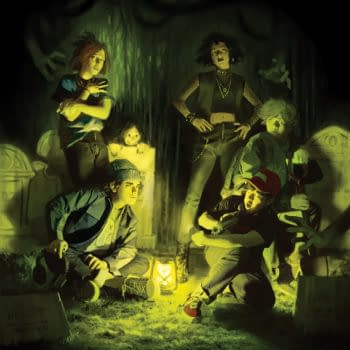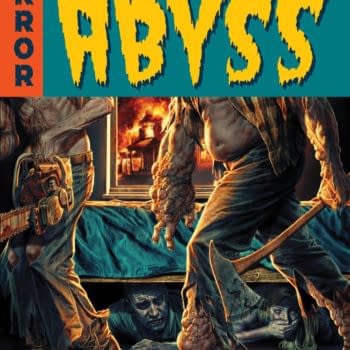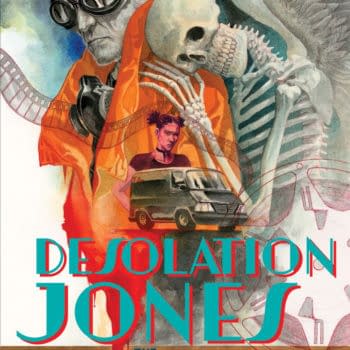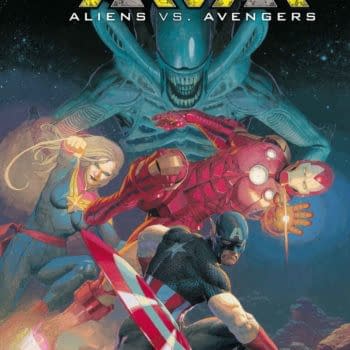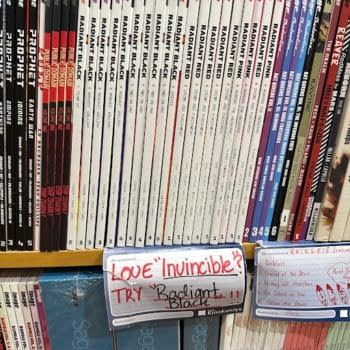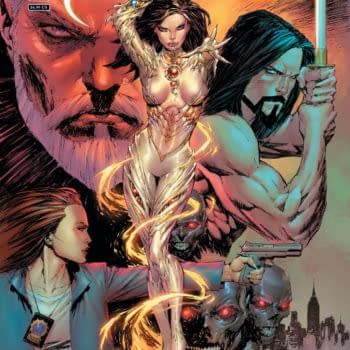Posted in: Comics, Look! It Moves! by Adi Tantimedh | Tagged:
Look! It Moves! #56: The Runaway Literary Life Of Doctor Who

I thought I was done, but felt I didn't get to say everything I wanted to say beyond recapping what the Virgin novels were. I suppose what really interested me in the book scene for WHO was the way it crossed over from fan scene to professional. The only other franchise that used to have this was the Star Trek fan scene. Trek was the only show in Hollywood with an open script submissions policy and while the vast majority of scripts sent in by fans were fan fiction and dross, a few writers got their first breaks by submitting a script and being offered jobs as staff writers on STAR TREK: THE NEXT GENERATION, DEEP SPACE 9 and VOYAGER before moving onto impressive careers in television. Writers like Ron Moore, Brannon Braga and Jane Espensen, but to name a few are now established as Science Fiction and Fantasy TV writers of note, having been put in charge of shows like the rebooted BATTLESTAR GALACTICA, CAPRICA, WAREHOUSE 13 and so on.
 Science Fiction and Fantasy franchises need fans to stay alive. Fans are their lifeblood much more than for non-genre properties. I've always been interested in the cultures that spring up around geek pop, be it anime/manga, Science Fiction & Fantasy, Comics, TV shows (well, not so much the TWILIGHT franchise) from a sociology or anthropological point of view. They have things in common, in that they become unified and identifiable communities with a common interest. What makes DOCTOR WHO's scene unique is how it turned out a whole set of professional writers who have branched out in other medium like comics and television, and the few that stayed within the publishing and fan community but still have fan followings of their own, and the various corners mutate and take on a life of their own. As discussed last week, and further in the forum discussion, these writers created a massive and deep alternate continuity for the Doctor and his universe during the show's hiatus.
Science Fiction and Fantasy franchises need fans to stay alive. Fans are their lifeblood much more than for non-genre properties. I've always been interested in the cultures that spring up around geek pop, be it anime/manga, Science Fiction & Fantasy, Comics, TV shows (well, not so much the TWILIGHT franchise) from a sociology or anthropological point of view. They have things in common, in that they become unified and identifiable communities with a common interest. What makes DOCTOR WHO's scene unique is how it turned out a whole set of professional writers who have branched out in other medium like comics and television, and the few that stayed within the publishing and fan community but still have fan followings of their own, and the various corners mutate and take on a life of their own. As discussed last week, and further in the forum discussion, these writers created a massive and deep alternate continuity for the Doctor and his universe during the show's hiatus.

To an outsider or a new fan of WHO, this can look hermetic and so complex as to be intimidating, and Russell T. Davies knew this when he prepared the show for its return in 2005. That's why he had to treat it as if it was a new show, keeping its back history and continuity mostly hidden in the background. He needed to entice new viewers, especially female viewers and kids, both of whom would run away if there was a whiff of anorak-level obsession with the show's past continuity. Everything had to be presented as if new and for the first. He was re-introducing a new generation of viewers to The Doctor, the Tardis, the Daleks, the show's surreal and sometimes campy treatment of Science Fiction and Time Travel. It took him more than two seasons before he would even call The Doctor's home planet by name again. Whenever one of the more obscure aliens appeared on the show, Davies never bogged them down with fanservice dialogue and left them there as Easter Eggs for older fans to notice. After Davies' run was over, Moffat felt confident enough in the show's now-established audience to be more overt about the fanservice and showing images of the last ten Doctors and adopt a generally even more fannish tone to the show.

Now, what about the notable writers of the Virgin and BBC novels who didn't go on to write for the show? Well, they still have careers either in writing scripts or writing more WHO novels as well as novelisations of other franchises, where it's entirely possible to earn a living, more than most prose authors trying to write original novels. The Virgin and BBC novels from the 90s may be out of print, but I was reminded of the tenacity of fandom when a chap named Alastair Shaw in Scotland emailed me to tell me about a project he's running called The Doctor Who Reprint Society.
Simply put, The Doctor Who Reprint Society wants to publish official new editions of key novels from the Virgin and BBC line in new, affordable editions, with royalties to be paid to the original authors. It's interesting to note what the site considers the key plotlines that should be collected into omnibus collections, since the list serves as a barometer for what the most popular titles in the Virgin and BBC line are.

THE TIMEWYRM QUARTET is a proposed omnibus collecting the first four of the Virgin novels that set the tone of the books for the next seven years the line would run. The fourth book, REVELATIONS, is Paul Cornell's debut which pulled the Alan Moore-style re-thinking of The Doctor.
THE OTHER DOCTOR would collect four novels that used showrunner Andrew Cartmel's masterplan that was to drive the 7th Doctor's story, namely the mystery of exactly what The Doctor was if he wasn't just a Timelord but had ties to another mysterious entity.
THE FIRST GREAT TIME WAR would collect the novels that covered the Time War that Lawrence Miles began in the BBC novels featuring the 8th Doctor, which ended with Gallifrey seemingly destroyed at The Doctor's hand and The Doctor amnesiac and left on Earth in the Victorian era to spent the next hundred years recovering his memory and his Tardis. It's obvious that Davies was inspired by this original version of the Time War in the novels, even down to The Doctor being the one to wipe out Gallifrey and the Timelords because they had become too much of a threat to the universe. Miles has bitterly complained that his original plan for how the Time War would end was not followed because the editors and other authors didn't agree with it.

PREVIOUSLY ON DOCTOR WHO would collect the Virgin and BBC novels that were either adapted into or inspired episodes of the new show, including Paul Cornell's HUMAN NATURE, the Bernice Summerfield story that inspired Rose Tyler going back in time to meet her dead father in "Father's Day", the novel that inspired Steven Moffat to write SILENCE IN THE LIBRARY and so on. This would make an interesting reference for fans who like to track these things.
LOST IN TIME would reprint the most sought-after books in the Virgin line that now go for insane amounts of money, including Russell T. Davies' one WHO novel DAMAGED GOODS, which took place on a council estate in Thatcher's Britain, featured an alien drug being sold, a young gay man trying to come to turns with his sexuality, and even a family name Tyler, essentially an embryonic version of what Davies would end up bringing to the show when he revived it in 2005.

DARK REFLECTION: FURTHER TALES OF THE VALEYARD would collect the novels that dealt with the Valeyard, the villain in the 6th Doctor's final TV season who turned out to be one of The Doctor's future selves, but who was seemingly wiped out of existence in the show. The Valeyard was and still is an ongoing obsession of longtime fans of the show, whose place in the Doctor's timeline is still debated to and beyond death, and there are fans who still expect him to show up in the new show at some point.
Then there are the collections of novels by notable authors like Lance Parkin, one of the most inventive writers in the line and in general, and Gary Russell, who started out as a WHO fandom activist who ended up running first the Big Finish audio drama line and then got hired by Davies to be script editor on TORCHWOOD. I've suggested that a Paul Cornell collection should be considered, since Paul is gathering a following with his comics work now and an omnibus would probably sell a decent number of copies.

It's fun to root around Alastair's site and feel a pang of nostalgia for that particular scene and period. Sure, some people might dismiss the books as fan fiction, but then they were professionally written, edited and paid for, and provided a training ground for a lot of up-and-coming writers, and as far as I'm concerned, the more opportunities there are for aspiring writers to get trained and paid at the same time, the better. It's also kind of heartening to see how writing never really dies out, even when out of print in the age of the internet, since there will always be fans who keep the flame alive. For newcomers to WHO, this is a decent reference point if they want to explore the intricacies of WHO fandom and fiction, areas to love, hate and argue obsessively about. It's all optional, of course, but it's fun if you're in the right state of mind, and to be a fan is, after all, a state of mind, and why websites like Alastair's – and Bleeding Cool, for that matter – exist.
All about the fun at lookitmoves@gmail.com.
© Adisakdi Tantimedh






